Marshall Roberts Collection
The Art Collection of Marshall Owen Roberts was a collection of sculpture, antiques and paintings owned by New York industrialist Marshall Owen Roberts. The collection, which featured many prominent American artists and works, including Emanuel Leutze's Washington Crossing the Delaware, remained intact following his 1880 death until it was auctioned off in 1897.
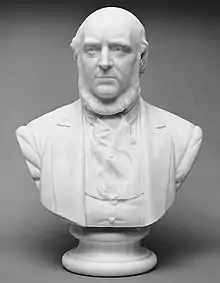
History
Roberts was a noted art collector and staunch supporter of American artists who never sold or exchanged a painting after he bought it.[1] He was considered the prototypical New York patron, like Gilpin in Philadelphia and Harrison Gray Otis in Boston.[2][3] He "made no pretensions to connoisseurship, but was guided in his purchases simply by fancy, or with a view to assisting some needy artist."[1] Roberts served on the Metropolitan Museum of Art's Board of Trustees in 1870 and 1871,[1] and lent some of his paintings to the Metropolitan Fair Picture Gallery in 1864 held at the Fourteenth Street Armory.[4]
Roberts formed his collection of 335 paintings[5] at a time when the Düsseldorf School of German genre paintings were the fashion and the canvases which told human stories were most worthy of attention.[6]
His best-known acquisition is Emanuel Leutze's 1851 painting Washington Crossing the Delaware,[lower-alpha 1][8] which he bought for $10,000 (at the time, an enormous sum).[9] Roberts built an art gallery, attached to his home, 107 Fifth Avenue (at the southeast corner of 18th Street), where he displayed his collection, which included Rembrandt Peale's Babes in the Wood,[10] Daniel Huntington's Venice, Good Samaritan[11] and Old Lawyer,[12] Frederick Stuart Church's Rainy Season in the Tropics[lower-alpha 2] and Coast of Maine, Régis François Gignoux's Hawk's Nest, West Virginia,[lower-alpha 3] Richard Caton Woodville's War News from Mexico, Asher Brown Durand's Indian Rescue, Schaeffele's Marie de Medici's Visit to Ruben's Studio, Johann Georg Meyer's First Lesson, Constant Troyon's After the Hunt, Paul Falconer Poole's Pension Agent, Charles Verlat's Sheep in Pasture, Paul Delaroche's Napoleon at Fontainbleau, Ernest Meissonier's The Smoker (1849) Thomas Sidney Cooper's Monarch of the Plain, Édouard Frère's Mother and Infant and The Industrious Mother,[13] John Frederick Kensett's Noon by the Sea Shore[lower-alpha 4] and Franconia Notch, Henry Peters Gray's Rose of Fiesole and Just Fifteen,[15] George A. Baker's Love at First Sight,[16] Wild Flowers and Children of the Wood, John George Brown's His First Cigar,[17] Thomas Cole's Old Mill, James McDougal Hart's Old Homestead and Morning in the Adirondacks,[18] William Henry Powell's Landing of the Pilgrims,[19] William Sidney Mount's Raffling for a Goose,[20] Robert Swain Gifford's On The St. Lawrence and View of Quebec, Eugene Benson's Thoughts in Exile, Thomas Sully's Woman at the Well and A Girl Offering Flowers at a Shrine,[21] Seymour Joseph Guy's A Field Daisy and Good Sister,[22] Charles Loring Elliott's Portrait of Himself, and George Henry Boughton's Gypsy Women, Jean-Léon Gérôme's The Egyptian Conscript,[23] James Augustus Suydam's On the Beach, Charles Baugniet's Dressing for the Ball, Benjamin Vautier's The Letter, as well as works by M. H. Koekkoek Édouard Detaille.[5]
In addition to the 1876 Indian Vase by his son-in-law Ames Van Wart, Roberts collection included a 1,000 different numbers in bronze, art objects and furnishings. His sculptures included Erastus Dow Palmer's medallion base-reliefs Night and Morning, Franklin Simmons's The Promised Land,[24] and Voso's Cupid and Psyche.[5]
Auction of collection
Roberts died on September 11, 1880 while in Saratoga, New York. The entire collection was left to his widow, the former Sarah Lawrence "Susan" Endicott. At the time of his death, it was reported that he had spent $600,000 (equivalent to $15,896,000 in 2019) on the collection which was then worth over $750,000 (equivalent to $19,870,000 in 2019).[1] In 1892, Susan remarried to Ralph Vivian of Claverton Manor[25][26][27] They moved to London and the collection remained in the Fifth Avenue home, which remained unoccupied other than during the winter of 1893 to 1894 when Cornelius and Alice Gwynne Vanderbilt leased the mansion while they were expanded their chateau at Fifth Avenue and 57th Street.[6]
In 1897, Susan hired Messrs. Ortgies & Co. of the Fifth Avenue Art Galleries, under the management of Samuel P. Avery, Jr., to auction off the entire collection.[6] The auction of the paintings took place at Chickering Hall on the evenings of January 19, 20, and 21, 1897. The statuary, art objects, and other furnishings were auctioned off from the Fifth Avenue home on January 18 and 22.[6]
In total, $41,754 (equivalent to $1,283,000 in 2019) was received for the sale of 172 pictures, $8,764 during the first night's sale and $32,990 the following night at Chickering Hall.[7] The Roberts home on Fifth Avenue was sold and in July 1901, architect Robert Maynicke filed plans for a new eleven-story building to be erected by Henry Corn on the site of home.[28] The new building, extant today at 105 Fifth Avenue, was original location of the Barnes & Noble chain of bookstores from 1932 to 2014.[29]
Collection
- Paintings
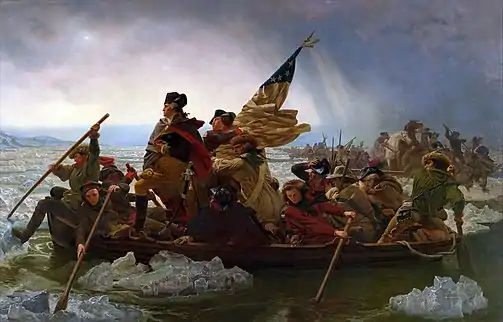
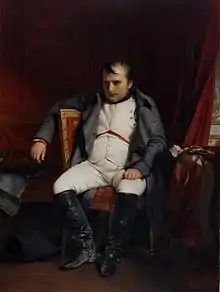 Napoléon à Fontainebleau by Paul Delaroche, 1840
Napoléon à Fontainebleau by Paul Delaroche, 1840_MET_DT1511.jpg.webp) Raffling for the Goose by William Sidney Mount, 1837
Raffling for the Goose by William Sidney Mount, 1837 War News from Mexico by Richard Caton Woodville, 1848
War News from Mexico by Richard Caton Woodville, 1848 The Smoker by Ernest Meissonier
The Smoker by Ernest Meissonier Rainy Season in the Tropics by Frederic Edwin Church, 1866
Rainy Season in the Tropics by Frederic Edwin Church, 1866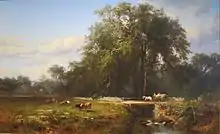 The Old Homestead by James McDougal Hart, 1862
The Old Homestead by James McDougal Hart, 1862 Indian Rescue by Asher Brown Durand
Indian Rescue by Asher Brown Durand
- Sculpture and pottery
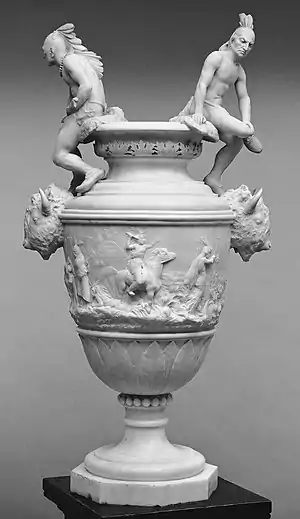 Indian Vase by Ames Van Wart, 1876
Indian Vase by Ames Van Wart, 1876 The Promised Land by Franklin Simmons, carved 1874
The Promised Land by Franklin Simmons, carved 1874 Morning by Erastus Dow Palmer, 1854
Morning by Erastus Dow Palmer, 1854
References
- Notes
- Roberts kept Emanuel Leutze's Washington Crossing the Delaware, which he acquired the early 1860s, in a fixed frame which occupied the entire eastern wall of the gallery. It was noted in the catalog of the sale that the purchaser of the painting "will be obliged to remove it from its position in the gallery at his own risk and expense."[5] It was purchased by John Stewart Kennedy for $16,100 (equivalent to $495,000 in 2019) who donated it to the Metropolitan Museum of Art.[7]
- Frederick Stuart Church's Rainy Season in the Tropics sold for $1,550 (equivalent to $48,000 in 2019) to S.O. Wright & Co., presumably for a customer.[7]
- Régis François Gignoux's Hawk's Nest, West Virginia was considered by The New York Times in 1897 to be "the best landscape that Gignoux ever painted, and which, even with its defects and its indices of an art school long dead, can be studied with pleasure for its lovely light, good distance, and soft color."[5]
- John Frederick Kensett's 1863 Noon by the Sea Shore was a scene of the cliff walk at Newport, painted long before that walk had become the formal and aristocratic path that it became.[5] It was later owned by Samuel P. Avery, Jr.[14]
- Sources
- "Marshall O. Roberts Dead; the Life of One of New York's Merchants Ended". The New York Times. 12 September 1880. Retrieved 28 May 2020.
- Harris, Neil (1982). The Artist in American Society: The Formative Years. University of Chicago Press. p. 280. ISBN 978-0-226-31754-0. Retrieved 28 May 2020.
- Jackson, Kenneth T.; Keller, Lisa; Flood, Nancy (2010). The Encyclopedia of New York City: Second Edition. Yale University Press. p. 4508. ISBN 978-0-300-18257-6. Retrieved 29 May 2020.
- Howe, Winifred E. (1914). A History of The Metropolitan Museum of Art, with a Chapter on the Early Institutions of Art in New York. Metropolitan Museum of Art. p. 91. Retrieved 29 May 2020.
- "THE MARSHALL O. ROBERTS ART COLLECTIONS". The New York Times. January 9, 1897. Retrieved 30 May 2020.
- "M.O. ROBERTS'S TREASURES; ALL WILL BE SOLD AT AUCTION IN THIS CITY. The Pictures, Statuary, and Art Objects of the Once Famous Collection Were Left to the Widow, Now Mrs. Ralph Vivian". The New York Times. January 5, 1897. p. 3. Retrieved 30 May 2020.
- "PAINTING TO REMAIN HERE; "Washington Crossing the Delaware" Bought by J.S. Kennedy. GIFT FOR MUSEUM OF ART. He Paid $16,000 for the Picture at the Roberts Sale -- Men Representing the Corcoran Art Gallery in Washington Bid Against Him". The New York Times. 21 January 1897. Retrieved 1 June 2020.
- "Marshall O. Roberts | 1884 | Ames Van Wart American". www.metmuseum.org. Metropolitan Museum of Art. Retrieved 28 May 2020.
- "Washington Crossing the Delaware 1851 Emanuel Leutze". www.metmuseum.org. Retrieved 28 May 2020.
- Benjamin, Samuel Greene Wheeler (1880). Art in America: A Critical and Historical Sketch. Harper & Brothers. p. 28. Retrieved 29 May 2020.
- "PAINTING FOR NEW JERSEY.; Huntington's "Good Samaritan" to Hang in Trenton". The New York Times. 2 April 1897. Retrieved 1 June 2020.
- Luhrs, Kathleen (1965). American paintings in the Metropolitan Museum of Art. Metropolitan Museum of Art. p. 65. ISBN 978-0-87099-439-5. Retrieved 1 June 2020.
- Round Table. H. E. and C. H. Sweeter. 1863. p. 266. Retrieved 29 May 2020.
- N.Y.), Metropolitan Museum of Art (New York; Story, George Henry (1900). Catalogue of the Paintings in the Metropolitan Museum of Art. The Metropolitan Museum of Art. p. 42. Retrieved 1 June 2020.
- Bryan, Michael (1903). Bryan's Dictionary of Painters and Engravers. G. Bell. p. 273. Retrieved 29 May 2020.
- Book of the Artists: American Artist Life, Comprising Biographical and Critical Sketches of American Artists: Preceded by an Historical Account of the Rise and Progress of Art in America. G.P. Putnam & son. 1870. p. 489. Retrieved 29 May 2020.
- The Outlook. Outlook Company. 1913. p. 378. Retrieved 29 May 2020.
- Howard, Henry Ward Beecher; Jervis, Arthur N. (1893). The Eagle and Brooklyn: The Record of the Progress of the Brooklyn Daily Eagle. Brooklyn Daily Eagle. p. 783. Retrieved 29 May 2020.
- "Discovery of the Mississippi by De Soto". www.aoc.gov. Architect of the Capitol. Retrieved 29 May 2020.
- Caldwell, John; Roque, Oswaldo Rodriguez; Johnson, Dale T. (1994). American Paintings in The Metropolitan Museum of Art. Vol. 1: A Catalogue of Works by Artists Born by 1815. Metropolitan Museum of Art. p. 515. Retrieved 29 May 2020.
- Waters, Clara Erskine Clement; Hutton, Laurence (1884). Artists of the Nineteenth Century and Their Works: A Handbook Containing Two Thousand and Fifty Biographical Sketches. J. R. Osgood. p. 279. Retrieved 29 May 2020.
- Appletons' Journal. D. Appleton and Company. 1875. p. 827. Retrieved 29 May 2020.
- Trumble, Alfred (1889). The Art Collector: A Journal Devoted to the Arts and the Crafts. A. Trumble. p. 150. Retrieved 29 May 2020.
- Gardner, Albert Ten Eyck; N.Y.), Metropolitan Museum of Art (New York (1965). American Sculpture: A Catalogue of the Collection of the Metropolitan Museum of Art. Metropolitan Museum of Art. p. 36. Retrieved 1 June 2020.
- Who's Who. A. & C. Black. 1910. p. 1991. Retrieved 28 May 2020.
- The American Almanac, Year-book, Cyclopaedia and Atlas. New York American and Journal, Hearst's Chicago American and San Francisco Examiner. 1903. p. 172. Retrieved 28 May 2020.
- "Ralph Vivian Married; Mrs. Marshall O. Roberts Becomes His Bride. a Throng of Guests at the Ceremony -- Beautiful Floral Decorations -- Brilliant Reception After the Wedding". The New York Times. 8 January 1892. Retrieved 28 May 2020.
- "IN THE REAL ESTATE FIELD; Isaac H. Clothier Buys a Plot on East Ninety-fifth Street -- Other Dealings and Auction Sales". The New York Times. 9 July 1901. Retrieved 1 June 2020.
- "105 Fifth Avenue, the Folio Building". landmarkbranding.com. Landmark Branding LLC. 6 June 2014. Retrieved 1 June 2020.
External links
| Wikimedia Commons has media related to Marshall Roberts Collection. |